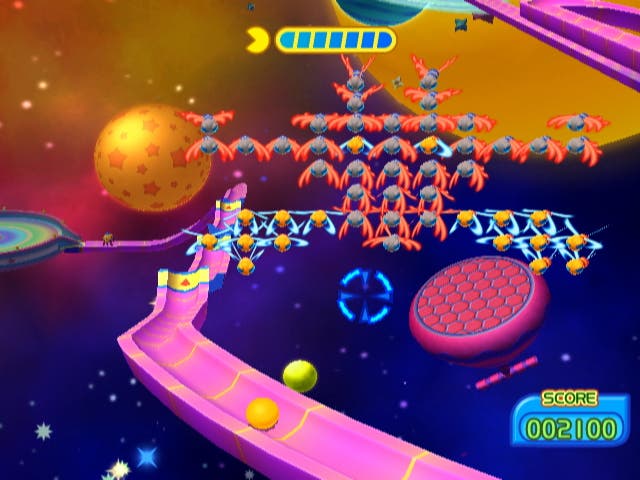Namco Museum Remix
Surely Namco Museum Wiimix? A missed opportunity.
And the same could be said for Galaga Remix, really. The fluid precision of the Wii's remote makes it simple to aim and blast wave upon wave of Galaga-inspired alien craft, but the extra-gentle learning curve and crushing repetition makes it a rather tiresome tribute. Ridiculously, Namco even managed to shoe-horn Pac-Man into Galaga Remix, with the yellow blob found rolling along a tube while the curiously cuddly-looking enemies swoop and attack in a manner befitting the arcade classic. With theme tune tributes burbling away in the background of each of the games included, it's a slightly irritating backdrop, with an incredibly simplistic approximation of the gameplay trivialising what these twitch classics were good at in the first place.
The presence of arcade originals - presumably as a concession to the old school - could rescue the package to some degree, except there are very few included and we've played them all to death. With just nine included, the compilation is neither remotely comprehensive nor savvy enough to include the obvious big-hitters. Glaringly absent are the likes of Pac-Man, Ms. Pac-Man and Pole Position, not to mention the original versions of Motos, Rally-X and Galaga - a puzzling decision.
Instead, we're served up Dig Dug, Galaxian and Xevious for the umpteenth time, alongside titles which only really warrant inclusion to accompany the main dish. While we're more than happy to celebrate the less high-profile titles in such compilations, the truth is that most of these are uninspired filler, ill-advised follow-ups or just plain rubbish. By far the worst offender is Cutie Q, an uninspired mixture of Breakout and pinball from 1979. For historical interest, it's great, because it was made by Pac-Man creator Toru Iwatani, but only the most forgiving retro apologist could sit and play it for more than a few minutes without wanting to move on - especially as this was a game designed for a paddle controller.

The hugely underwhelming official Pac-Man sequel, Super Pac-Man, also makes an appearance here, serving to remind us exactly why it bombed back in 1982. Completely changing the premise, the idea was to eat keys to open doors, and clear each maze of fruit. But as well as being able to eat the standard power pellets, super pellets transformed the little chomper temporarily into a giant-sized Pac-Man, allowing him to eat through walls and remain invulnerable to the ghosts. The problem then, as now, was fiddly controls, and with none of the game's original charm, its inclusion only serves to annoy.
A variant on some of the ideas debuted in Super Pac-Man, 1983's Pac & Pal also gets thrown in, but, again, it's not difficult to see why it wasn't a big hit at the time. Instead of collecting keys like in Super Pac-Man, you must go around the maze turning over cards to unlock the doors that house the objects you need. This time around, you're somewhat aided in your travels by 'Mill', a little green female ghost who carries objects which might be of use. In addition, you can perform a special attack for a limited time, such as being able to fire a beam to stun ghosts. The super-hardcore might find them interesting, but neither Super Pac-Man or Pac & Pal can hold a candle to the original - nor can the pointless PacMania, an isometric 3D take on the game that started it all - albeit with the ability to jump. With its teeth-grindingly jolly theme tune, it got by back in the day for the pure novelty of how good the graphics looked, but nowadays it feels like a another uninspired attempt to cash-in on a fading legacy.

To wrap up, Galaga follow-up Gaplus (a.k.a. Galaga 3) is renowned for being a rewarding, hardcore version of the hugely popular shooter, and Galaxian has an indefinable classic charm (mainly because of the sound effects), but we'd still rather play the middle game, Galaga, any day, because it nailed the Space Invaders formula so perfectly. Why it's not included, only Namco can answer. How difficult would that have been?
Overall, if you're still searching for the definitive Namco collection, this isn't it. The remixes are lacklustre and the paltry inclusion of nine largely throwaway oldies typifies the mean-spirited approach that Namco always applies to its Museum collections. For completists, the new version of Pac N' Roll is fun for a while and by far the most interesting part of the package, but, as usual, we're complaining like grumpy old men about what might have been.
